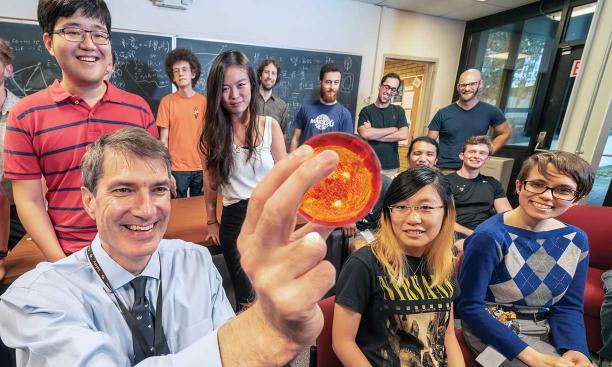
For more than 70 years, physicists have been trying to achieve controlled nuclear fusion — the process that powers the sun and the thermonuclear (i.e., hydrogen) bomb — and for nearly as long, critics have been yanking their chains. “They said they were going to give us fusion within 30 years,” goes an often-repeated jibe. “And they’re still saying it today.”
But is that joke becoming obsolete? At a livestreamed White House summit convened in March to assess the state of fusion research, physicists argued that fusion power could be nearly within our grasp. That’s a big deal: Controlled fusion would have some crucial advantages over controlled fission, the kind of nuclear energy we’re all familiar with. With fusion, unlike with fission, there’s no such thing as a meltdown. Fusion also creates vastly less radioactive waste. Plus the fuel source isn’t a heavy element such as uranium, which must be mined at great expense, but rather hydrogen, which can be extracted from sea water. Finally, because fusion produces essentially no planet-warming greenhouse gases, it could be a big part of the solution to climate change.
Participants in the summit were upbeat. Steven Cowley *85, director of the Princeton Plasma Physics Laboratory (PPPL), said that last August, an experiment at the Lawrence Livermore National Laboratory’s National Ignition Facility generated 1.3 megajoules of power with an input of just under 2 megajoules of power — not quite a net gain, but unprecedentedly large. In December, the Joint European Torus in the United Kingdom produced an average of 10 million watts for five seconds — again, a record, though that’s still a long way from a commercial fusion plant.
Meanwhile, the Department of Energy (DOE) has brought all the fusion research it funds under one umbrella, signaling a new seriousness about the technology, and has announced $50 million in new funding to support fusion science. Legislation has been introduced to provide another $6 billion over the next five years. Private companies have attracted investors who see a major role for fusion-powered electricity in years to come. “We don’t think that acceleration of fusion will happen without the private investment,” Cowley told PAW.
What has Cowley most excited are developments over the past decade in the understanding of how the super-hot, electrically charged gas known as plasma behaves in a fusion reactor. “And that’s mostly come out of Princeton,” he said.
Princeton’s involvement in fusion research dates to 1951, when Lyman Spitzer *38, a professor of astrophysics and the director of the Princeton University Observatory, hit on an idea. The primary discovery that came of the Manhattan Project during World War II was, of course, the atomic bomb, which got its destructive force from fission — splitting the nuclei of heavy atoms such as uranium and plutonium — to release unprecedented amounts of energy. Nuclear plants now provide about 10 percent of the world’s electricity. Physicists also understood that nuclear fusion, the reaction that makes the sun and other stars shine, releases vastly more energy and could create electricity as well. It would be a lot harder: Hydrogen nuclei in a hot plasma have a positive electric charge and naturally want to repel each other. In the center of the sun, that repulsion is overcome by the star’s crushing gravity, which generates intense heat. In an H-bomb, the heat is generated by a fission bomb, which acts as a trigger. For steady power output (to say nothing of avoiding a massive explosion), that’s not an option.
What Spitzer realized was that if you could confine plasma inside a powerful magnetic field and heat it up to millions of degrees with powerful radio waves, the nuclei would crash into one another and fuse, generating more heat to maintain the reaction. The federal Atomic Energy Commission funded Spitzer’s idea of a device he called a stellarator, and the work proceeded at a lab at Princeton’s Forrestal campus. The Princeton Plasma Physics Laboratory is still working on the problem.
Spitzer’s stellarator concept returned to the back burner in the late 1960s because the powerful magnets that confined the plasma required a complex configuration that was impossible to design at the time. The lab switched to a Russian design known as a tokamak — a donut-shaped machine in which the plasma generates its own magnetic field, helping the external magnets herd the nuclei together. Tokamaks are currently the leading candidate for commercial controlled fusion (the National Ignition Facility, mentioned above, uses a different technology involving powerful lasers). The International Thermonuclear Experimental Reactor (ITER), a tokamak under construction in southern France, is the world’s largest fusion experiment. Princeton is contributing theoretical expertise to that project.
But Spitzer’s stellarator concept has recently been revived because supercomputing has reached a level where the complex physics of a hot, turbulent plasma can finally be modeled. “That’s what’s really new,” said Cowley. “That’s what they didn’t have in the ’50s and ’60s.” He cites the recent work of Elizabeth Paul, a Presidential Postdoctoral Fellow at Princeton, and Matt Landreman, at the University of Maryland, who published a paper outlining a new way to solve the design problems that plagued the original stellarators.
“The solution to reliable controlled fusion,” said Cowley, “may actually lie where Spitzer thought it would lie in the first place. He just was too far ahead of his time.”
